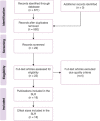On usage of artificial intelligence for predicting mortality during and post-pregnancy: a systematic review of literature
- PMID: 36536413
- PMCID: PMC9764498
- DOI: 10.1186/s12911-022-02082-3
On usage of artificial intelligence for predicting mortality during and post-pregnancy: a systematic review of literature
Abstract
Background: Care during pregnancy, childbirth and puerperium are fundamental to avoid pathologies for the mother and her baby. However, health issues can occur during this period, causing misfortunes, such as the death of the fetus or neonate. Predictive models of fetal and infant deaths are important technological tools that can help to reduce mortality indexes. The main goal of this work is to present a systematic review of literature focused on computational models to predict mortality, covering stillbirth, perinatal, neonatal, and infant deaths, highlighting their methodology and the description of the proposed computational models.
Methods: We conducted a systematic review of literature, limiting the search to the last 10 years of publications considering the five main scientific databases as source.
Results: From 671 works, 18 of them were selected as primary studies for further analysis. We found that most of works are focused on prediction of neonatal deaths, using machine learning models (more specifically Random Forest). The top five most common features used to train models are birth weight, gestational age, sex of the child, Apgar score and mother's age. Having predictive models for preventing mortality during and post-pregnancy not only improve the mother's quality of life, as well as it can be a powerful and low-cost tool to decrease mortality ratios.
Conclusion: Based on the results of this SRL, we can state that scientific efforts have been done in this area, but there are many open research opportunities to be developed by the community.
Keywords: Deep learning; Infant mortality; Machine learning; Neonatal mortality; Stillbirth.
© 2022. The Author(s).
Conflict of interest statement
The authors declare that they have no competing interests.
Figures









Similar articles
-
Machine Learning Models for Predicting Neonatal Mortality: A Systematic Review.Neonatology. 2021;118(4):394-405. doi: 10.1159/000516891. Epub 2021 Jul 14. Neonatology. 2021. PMID: 34261070 Free PMC article.
-
The effects of completion of continuum of care in maternal health services on adverse birth outcomes in Northwestern Ethiopia: a prospective follow-up study.Reprod Health. 2022 Oct 8;19(1):200. doi: 10.1186/s12978-022-01508-5. Reprod Health. 2022. PMID: 36209163 Free PMC article.
-
Predictive Modeling for Perinatal Mortality in Resource-Limited Settings.JAMA Netw Open. 2020 Nov 2;3(11):e2026750. doi: 10.1001/jamanetworkopen.2020.26750. JAMA Netw Open. 2020. PMID: 33206194 Free PMC article.
-
NeoAI 1.0: Machine learning-based paradigm for prediction of neonatal and infant risk of death.Comput Biol Med. 2022 Aug;147:105639. doi: 10.1016/j.compbiomed.2022.105639. Epub 2022 May 18. Comput Biol Med. 2022. PMID: 35635905
-
Care prior to and during subsequent pregnancies following stillbirth for improving outcomes.Cochrane Database Syst Rev. 2018 Dec 17;12(12):CD012203. doi: 10.1002/14651858.CD012203.pub2. Cochrane Database Syst Rev. 2018. PMID: 30556599 Free PMC article.
Cited by
-
Explore the factors related to the death of offspring under age five and appraise the hazard of child mortality using machine learning techniques in Bangladesh.BMC Public Health. 2025 Jan 29;25(1):360. doi: 10.1186/s12889-025-21460-w. BMC Public Health. 2025. PMID: 39881228 Free PMC article.
-
Application of machine learning in identifying risk factors for low APGAR scores.BMC Pregnancy Childbirth. 2025 May 8;25(1):548. doi: 10.1186/s12884-025-07677-y. BMC Pregnancy Childbirth. 2025. PMID: 40340577 Free PMC article.
-
Advances in AI and machine learning for predictive medicine.J Hum Genet. 2024 Oct;69(10):487-497. doi: 10.1038/s10038-024-01231-y. Epub 2024 Feb 29. J Hum Genet. 2024. PMID: 38424184 Free PMC article. Review.
-
Patients' knowledge, attitudes, and practices regarding lifestyle related dry eye.Sci Rep. 2025 Apr 8;15(1):12050. doi: 10.1038/s41598-025-97290-y. Sci Rep. 2025. PMID: 40199979 Free PMC article.
-
Machine learning models based on clinical indices and cardiotocographic features for discriminating asphyxia fetuses-Porto retrospective intrapartum study.Front Public Health. 2023 Mar 20;11:1099263. doi: 10.3389/fpubh.2023.1099263. eCollection 2023. Front Public Health. 2023. PMID: 37033082 Free PMC article.
References
-
- UNICEF. A neglected tragedy: the global burden of stillbirths. Report of the UN Inter-agency Group for Child Mortality Estimation, 2020. https://www.unicef.org/reports/neglected-tragedy-global-burden-of-stillb... (2021/10/20).
-
- D’Antonio F, Odibo A, Berghella V, Khalil A, Hack K, Saccone G, Prefumo F, Buca D, Liberati M, Pagani G, et al. Perinatal mortality, timing of delivery and prenatal management of monoamniotic twin pregnancy: systematic review and meta-analysis. Ultrasound Obstet Gynecol. 2019;53(2):166–174. doi: 10.1002/uog.20100. - DOI - PubMed
-
- World Health Organization. Newborn Mortality. 2022. https://www.who.int/news-room/fact-sheets/detail/levels-and-trends-in-ch... (2022/05/20)
-
- World Health Organization. Number of infant deaths (between birth and 11 months). 2022. https://www.who.int/data/gho/data/indicators/indicator-details/GHO/numbe... (2022/05/20)
Publication types
MeSH terms
LinkOut - more resources
Full Text Sources
Miscellaneous

